Different Ways of Disposing of Sharps

By Gracie Hogue, BM
A part of the OSHA Manual that is often overlooked is the Waste Management section. Disposing of used sharps properly is essential, and there are different ways of doing that. Before getting into those options, here is a refresher on instruments classified as sharps:
- Needles
- Scalpel blades
- Orthodontic wires
- Orthodontic bands
- Burs
- Endodontic files
Never fill your sharps containers above ¾ of the way full. When the container has reached that level, wear utility gloves while making sure the lid of the container is completely and securely closed. Take the container and place it in a secure away from patients, vendors, exposed elements, or public places. The container will stay here until the pickup service or mail-in service is completed.
There are different options to handle your sharps container:
- Pickup service: Companies such as Stericycle will come to the practice and routinely pick up the full and contaminated sharps containers. Place the sharps container in the box lined with a red bag provided by the waste management vendor. Again, make sure the box is located in a secure and designated area. The waste management vendor then removes the box according to the terms of the contract.
- Mail-In service: Companies such as Sharps Assure provide you with everything you need to mail in your sharps containers safely. Follow the waste management vendor’s instructions for securing the sharps container and mailing the provided box.
- Isolysers and/or SMS Containers: This is an in-office treatment and disposal product that disposes of sharps. Place sharps in the Isolyser/SMS container, which is pre-filled with liquid monomer. When full, add two catalyst packets. This will activate the monomer, generate heat and solidify the sharps into a solid polymeric matrix. Once solidified, the needles are encapsulated, rendered unusable, destroyed and safe for disposal in the regular trash. NOTE: Disposal of activated Isolyser/SMS containers as “regular” office trash is allowed in the following States: AK, AZ, AR, CA, CO, GA, HI, ID, IL, IN, IA, KS, KY, LA, MA, MI, MO, MS, MT, NE, NV, NC, ND, OH, OK, PA, SC, SD, TN, TX, UT, WA, WI, WV, & WY.
- Medical Waste Machine: The Practice sterilizes filled sharps containers and biohazardous waste prior to disposal so that the contents are made nonhazardous. The Practice consulted with the local waste management authorities to verify that waste rendered nonhazardous may be disposed of as regular waste. For biohazardous waste such as bloody gauze and contaminated paper products, place the waste in the receptacle labeled “biohazardous”. Use an autoclave or chemical vapor sterilizer. Set the timer to 40 or 60 minutes. Consult with the manufacturer of the sharps container for specific instructions. Following the cycle, allow the container to cool and dispose of the container as required by law. For sharps waste, place the sharps container in the Medical Waste Machine. (http://www.medicalinnovationsinc.com/sharps.html)
During this entire process, it is vital to maintain records of waste processing! Don’t forget the name of the operator, the method of sterilization, and the date. Also, indicate the temperature and dwell time (the time chamber contents remained at the sterilizing temperature/pressure). Maintain records for 3 years or as required by law and local regulations.
If you have any questions or concerns, please contact [email protected]




